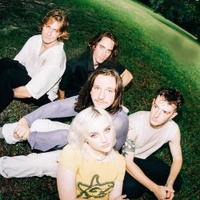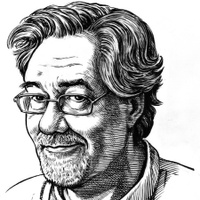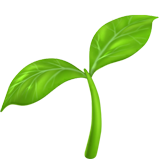On locating your inspiration
Prelude
Dylan Rose Rheingold (1997, New York) lives and works in New York City. She received her MFA in Painting from The School of Visual Arts (New York) and her BFA from Syracuse University (Syracuse). She has had recent solo exhibitions at Public Service Gallery in Stockholm, M+B in Los Angeles, and Jupiter Contemporary in Miami. Her paintings have been featured in exhibitions at Thierry Goldberg Gallery, New York; V1 Gallery, Copenhagen; Latitude Gallery, New York; WOAW Gallery, Hong Kong; and Grove Collective, London; amongst others. Her works have been written about in ArtNet, Juxtapoz, Dazed, Architectural Digest, and Hyperallergic, among others.
Conversation
On locating your inspiration
Painter Dylan Rose Rheingold discusses automatic drawing, turning a canvas over and starting anew, and channeling nostalgia in her imagery.
As told to Sammy Steiner, 2512 words.
Tags: Art, Painting, Beginnings, Process, Focus, Inspiration.
What have you learned about yourself through painting as a mirror?
I feel like the answer to that is also in your question. The act of painting does force you to look in the mirror, even when you don’t want to or when you’re trying to avoid that parallel. I think with my practice, especially the start of all my bodies of work, I really gravitate towards this surrealist exercise that’s called automatic drawing. Most people aren’t familiar with it, but they’re more familiar with automatic writing. Automatic writing is really just trying to clear your mind of anything preconceived—like the opposite of an underpainting sort of mindset—and letting your hand work in a way where you have no plan.
For me, I’ll make a bunch of drawings like that, and paintings on paper, all different sorts of mixed mediums. Then I’ll hang them all up on my wall or lay them out on the floor. I try to connect the dots a bit and see what objects or symbolism are repeating and why. Most of the time, there is always some form of repetition. It’s always very interesting because they’re ideas or objects that I wasn’t thinking about prior, or I didn’t think were so impactful. The more I start working with them and taking them apart, the more I realize there are connections to childhood experiences—ways in which certain objects represent something that feels half tapped into my adolescence and half tapped into problems or experiences I’m thinking about today. A lot of that has subconsciously led me into the bulk of where my practice is at now, which really teeters on the in-between space between child and adult, or girl and woman. Finding the gaps in time and space that sort of represent those feelings.
When you’re engaging in automatic drawing or writing, does it feel like you’re having a conversation with your subconscious?
Sort of. I think that’s why, when I start a new series or body of work, I’ve gotten into the routine of always starting off by doing a bunch of those drawings. I don’t find them to be effective if you only have a couple of them. What makes that process so special for me comes into play after the drawings are done. The drawings become activated in a setting that is nonlinear, and all of the works on paper are in conversation with each other—they act or react based on one another. If they were just singular pieces, they wouldn’t have the same impact at all.
How would you say nostalgia plays a role in your paintings as you uncover childhood memories and capture mundane moments?
Most of the experiences or settings I’m exploring are intentionally super mundane or banal. I’m not trying to make a spectacle of any sort of experience or setting. I realized that formally, or stylistically, my line work can come across as if I’m representing figures in a way that’s a bit more “grotesque,” which is unintentional—it’s just a little bit more raw. I have to be cautious of nostalgia, with the little details I include and with the color palettes I use, to make it clear to the viewer that the people, ideas, and moments I’m depicting are coming from a positive, reflective point. I’m not exploiting anyone or anything. It’s more of a reminiscence or a point of reflection… I don’t want to say an “uplifting” canon, but yeah. Does that make sense?
Yeah. Do you feel like nostalgia, or representing nostalgic memories, softens what you were describing as your more “grotesque” figuration?
That definitely helps. The pairing, or the duality of it, is a little unusual. But it helps bring all different types of people back to a very specific moment in time. It’s really special to me. I feel like my biggest takeaway about success—and how I view other people’s art and my own artistic practice—is that if it makes you feel something, regardless if that’s a positive or negative feeling, and evokes some sort of genuine emotion, then that is the magic of it all. So I think nostalgia is a funny thing. It’s definitely a root of my practice, and it goes a long way with my audience. Most people can understand that it’s coming from that source. It just leads down many different paths.
Do you have any symbols or themes that have stood out to you as your favorites? Or the most shocking or most confronting in your work?
Over the past few years, I’ve noticed that one of the symbols I include quite often—which wasn’t pointed out until somewhat recently during a studio visit—is this bunny rabbit character. I was gifted a bunny rabbit stuffed animal after my mom gave birth to me, from one of her best friends: this really skinny, lanky, long-legged bunny rabbit that I called Hop Hop. I still have him at my house on display. Hop Hop kind of appears in many of my paintings. It’s interesting because he is a good example of something that’s a direct link to adolescence, or youth, in a way that makes you do a double take and think.

Hop-Hop 1, 2023, acrylic, marker, molding paste on canvas, 18 x 24 inches.
A lot of your motifs are centered around play as a kid. Does painting feel like play, or does it feel like work?
Painting still feels like play, but in a way that holds more weight—a heavier type of play. As I get older, I realize that because this is my job—even if I didn’t view it as a job in my eyes—I feel like it’s something that I have to do. I have to get these ideas and thoughts out. It’s almost like my responsibility or moral duty to do so. When I don’t, I feel clogged. So, yes it does feel like play, but it feels like I have way more of a responsibility now to my practice.
In reference to feeling clogged, I guess you’re talking about it in a positive sense, where you’re a channel for something larger. But have you ever felt stuck without an idea to work with? How do you nurture your inner artist and help the idea to come out?
I don’t ever feel stuck without an idea because I’m always working on multiple projects at once. If I’m feeling stuck formally with painting, or if I’m in a bit of a rut, I know myself well enough to take a break and seek inspiration in other art forms. I love to read, so I’ll pick up a book. I love to go to galleries and museums—I’ll learn something through that. I’ll see a movie… Just because you come to the studio every day, we’re not robots. It doesn’t mean you’re going to generate things consistently. It’s really important to be self-aware and know where you find inspiration.
After most shows, I do take a break from painting. I’ll go on a little hiatus where I’ll get really into writing, then drawing, and then I’ll go back to painting. It just depends. For this show [at T293 in Rome], the works are so big. That was a really big challenge, using my whole body. After this, working very small will be even more challenging, so I’m going to be working on these 10-by-10-inch wooden cube paintings. I think the duality of that will be a nice push for me. We’ll see what comes out of it.
How do you navigate the balance between art and commerce? How do you approach putting a dollar value behind your work?
I try not to think about those things while I’m in here [the studio]. Every artist is different, but I like to stick to a pretty consistent formula that my mentor in grad school advised me on. I pretty much price things consistently on their scale, and I try not to let emotional attachment steer or disrupt any pricing.
You mentioned grad school—during your MFA, you did a lot of archival work using photographs. I’m curious about your relationship between your various mediums of painting, drawing, illustration, etc.?
My biggest takeaway from graduate school came from a critique class I had with Marilyn Minter, who’s an amazing painter and photographer, and who also went to Syracuse. She really instilled in me that anything you put on a canvas, or anything you portray as a painting, is a painting. When I first started grad school, I thought that to be a painter, or to be taken seriously as a painter, I had to become more painterly: get super thick, only use oil paints, and focus on my form, brushstrokes, and the heaviness of that. Honestly, I’m way better at drawing than I am at painting. I enjoy drawing way more. That really serves me. I’ve fully embraced that self-awareness and openly state how drawing is the root of my painting practice, but it is a painting practice. Anyone who uses paint is a painter. It’s all just up to you how you want to portray yourself. I don’t think about the word “illustration” anymore. Illustrating is like catering to someone else’s voice, idea, or needs, whereas drawing is more tied to myself… But it’s all just verbiage.

Backwards Somersaults, 2024, oil stick, acrylic, pastel, spray paint, glitter on canvas, 74 x 55 inches.
You previously described your use of materials as “an intuitive act.” Have you always felt intuitive?
I have always considered myself to be an intuitive artist. I read this book while I was in grad school written by the philosopher John Dewey, Art as Experience. The book talks about how he favors the experience of making something over the final product. That really resonated with me. Going off that basis or guideline, I should be making work that really feeds me and makes me feel best. It’s different for everyone. For me, that’s definitely being intuitive and mixing these types of materials that wouldn’t typically be layered or used together. Were the works I was making before grad school more technically advanced or complete? Yes, but that wasn’t fueling me. So this is where I feel more comfortable—in this sort of process.
How has your personal experience of moving through the world as a woman with intersecting identities informed your work?
Given the mixed cultural and religious background I grew up in—which was never really forced upon me—it has had way more of an impact on my practice than I’ve come to realize. I’m so focused on the mundane and simple things, and not making a spectacle out of anything. The viewer can engage if they want to, and once they do, they’ll find out more.
On a formalist level, the way that I layer and mix these nontraditional materials together, merging them in a medium that is often not used, actually parallels my background pretty synchronistically. It’s funny because, again, going back to the subconscious, that’s not something I was doing intentionally. It’s just something that intuitively felt right. When I take a step back, it makes so much sense. The result of the different things that make me who I am—and this feeling or idea of otherness—inherently seeps into my work in a way that’s digestible and relatable. I think a lot of people can connect to it in that way, even if it’s not coming from their specific cultural or religious background. The duality of things in an untraditional manner, or just feeling like you’re seeping in between the cracks, is a universal experience for most women.
You’re following threads and making sense of your work kind of in reverse.
My work is so connected to my personal identity in a way that’s almost diaristic. It’s dealing with motifs, ideas, and thoughts of everyday life given that specific period of time. A lot of it is just me trying to make sense of the world, or my world, in really mundane, small ways. I’m such a curious person. I’m just trying to understand things, and this is my way of understanding or exploring certain ideas or narratives and seeing what comes of it. I feel like I don’t have the answers to anything, but I’m just trying to work them out.
What’s the moment like when a work is finished? Is it a knowing?
That’s tough. For me, the worst feeling in the world is overworking a painting. It’s something that I used to struggle with a lot. That was also when I wasn’t valuing art as an experience over the final product. I thought, the more detail and the more you buff something out [the better]. I couldn’t be farther from that side of the spectrum now. When I think that a work is done, I will flip it over and start working on something else in tandem. I’ll take a break before going back to it. I’ll give it a week, a couple of weeks, a month, whatever it is, and just let it marinate and see how I feel. My preference, for most of the paintings that I’m a fan of, always teeters more towards looking almost unfinished… Most of the time, for me, less is more and I don’t need to overpack something to get my message across.

Everybody Wants to Go Fast, 2024, oil, acrylic, pastel, china marker, charcoal, collaged linen on canvas, 60 x 48 inches.
What are you excited about?
I’m super excited about a popup exhibition at 40 Crosby Street in Soho at w/ Ward Community Arts Program opening May 16th, and my next solo show in Rome at the end of April at T293 gallery. This body of work is called Shadow Talk. I was thinking a lot about spotlights in a physical sense. Flashlights, people looking for things under beds, dancers or performers kind of being forced on a platform in one way or another. Some of the drawings weren’t metaphorical and they were [literal] performers, and then others were people in everyday life who feel like they have to sort of perform or put on an act to be taken seriously. It got me thinking about the different versions of ourselves that exist—sort of like skeletons in the closet or in relation to grieving—and how those different versions of yourself can sort of come and go, but are still with you in everyday life.
Dylan Rose Rheingold recommends:
A book of silly little poems, perhaps Do Angels Need Haircuts? by Lou Reed or The Flame by Leonard Cohen
A set of Danish egg cups
The film Birth by Jonathan Glazer
A pair of satin or lace evening gloves
May the Circle Remain Unbroken, a photography book by Corinne Day
- Name
- Dylan Rose Rheingold
- Vocation
- painter
Some Things
Pagination



